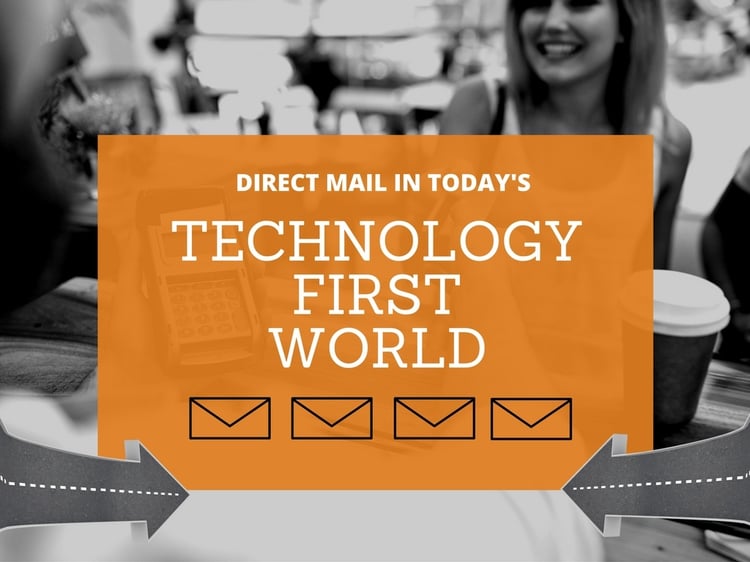
Although direct mail continues to remain relevant as a marketing weapon, many people are surprised to realize just how effective direct mail is in today’s technology-first world. Those who see direct mail as a relic from the past don’t understand how much the medium has changed in recent years and how it’s adapting to meet new challenges. The ongoing value of direct mail relates directly to how its methodology for distribution has evolved. It’s through enlightened direct mail circulation strategies that companies can continue to meet the needs of its consumers and provide a top-notch customer experience at all touchpoints.
Who Is the Modern Consumer?
As a whole, marketing goals haven’t deviated significantly from the core purpose of delivering timely and engaging messages to people who are most likely to be motivated by those messages. However, the manner in which companies employ this principle is more complex than ever.
Advances in technology allow marketers to reach customers in sophisticated new ways. The reach, speed and personalization that’s developed as a result of the Internet have given marketers the ability to spread their word in innovative and exciting formats. The only challenge is that customers now expect this treatment at all times, and across all platforms.
People are tired of receiving direct mail pieces addressed “Dear Valued Customer”. They want an individualized approach that reflects the lifestyles and preferences of each unique person. Today’s consumer wants to know that a company understands them, but more than that, today’s consumer wants to know that a company cares about them. Customers are more likely than ever to repay the loyalty of a company with repeat business and referrals to friends and family. But it’s up to the business to initiate that relationship with customized and engaging marketing.
What Is the Modern Path-to-Purchase?
According to an IBM study, 80 percent of consumers don’t believe they’re understood by the average brand. But this cynicism doesn’t mean that all hope is lost for marketers. It just means that they have to go about building their loyalty in a different way.
Customers today are more likely to give a product a chance after organic exposure than they are to try something following a traditional advertisement. It’s the experience, in which the consumer is a participant, that people really crave. The journey each customer undertakes when they see something new — conducting their own research, forming their own opinions, making purchases and sharing those experiences with others — is unique to this generation. Marketers can help nurture consumers along this journey by providing relevant information, but buyers ultimately want to feel like the choice was theirs. They don’t want the high-pressure sales pitch – they want to be the ones guiding the conversation.
The new path-to-purchase can begin anywhere, and it can end anywhere. An Instagram post can lead to a mail order, or an in-store demo can result in an online purchase. It all depends on what the customer likes, what moves that customer and how the customer prefers to make his or her purchases. What’s important is that marketers prepare for all possibilities by putting their best face forward and by truly embracing and including the customer, no matter what medium they choose.
How Direct Mail Circulation Is Changing
Direct mail has traditionally been slow to change with the times, mostly due to the effectiveness of previous planning methods and the cost of implementing new methodologies and technology. But that’s no longer the case. The wealth of information available to direct mail circulation planners has become far more affordable, easier to digest and enhances traditional transaction based circulation planning. Direct mail is leading the charge into the new era of marketing, in large part because of a revised approach to distribution.
In alignment with the digital revolution, direct mail circulation has benefited tremendously from the amount of affordable data available to marketers. What’s more, direct mail is increasingly becoming less of a silo-based operation and is more frequently integrated with other aspects of marketing campaigns. This holistic view of marketing, one in which online and offline data are combined to gain true understanding of the customer, provides you with a better understanding of when it is the right time to send a direct mail piece to your current customers as well as prospects.
Why You Should Incorporate Intent Data
Further evidence of the evolution of direct mail circulation can be seen in the tools available to ensure distribution to the most interested parties. Previous purchases were used as a guide for tailoring the marketing message to customers and prospects. While this was very helpful, the truth is that transactional data loses value at predicting future sales with each day that goes by. And transactional data does not tell you what your customers or prospects are interested in at this moment.
Once again, technology has proven to be a marketer’s best friend. Intent data — the digital clues left behind by online shoppers as they interact with your site and your social media accounts — is a tremendously effective way to improve your circulation strategy and response rates. Instead of the limiting view of transactional data, intent data provides you with current, relevant information about what your shoppers are interested in right now.
And intent data can be instrumental in understanding both current customers and unidentified web browsers. Intent data is a great way to zero in on the customers and prospects with the highest degree of interest.
What’s the Value of Personalization?
The proper use of intent data involves not only knowing how to spot those consumer clues, but also understanding how to respond in a way that encourages consumers to follow through on their desires and needs. Combining intent data with the ability to create personalized communications gives marketers the chance to send truly individualized pieces of direct mail — which, as you know, is exactly what today’s consumer wants.
For instance, a company can mail a postcard with a coupon for 25 percent off in Kitchen and Appliances after they see that a customer was searching their site for food processors, but left without making a purchase. The key is to make each piece of mail personal without being creepy. Personalized direct mail can also be used to thank customers for their loyalty or to let people know about upcoming promotions and product unveilings that they might be interested in. You can even send out promotional communications around the time at which a given customer typically spends a large amount of money, such as their significant other’s birthday or their anniversary.
The possibilities for personalization in direct marketing are limitless – but they have to be tied directly to the needs and wants of each individual customer. If someone feels as though they’re merely part of a mail blast, they’ll be quick to sour on your company’s products and overall message
What the Future Holds for Direct Mail
In today’s technology-driven world, direct mail isn’t usually the first marketing method most people think about. However, it’s perhaps the medium that has benefited most from the digital revolution. Today’s direct mail circulation methods are more efficient than ever, giving companies the ability to send personalized messages that stand out among the digital clutter. The continued incorporation of intent data and collaborations with other marketing divisions will help direct mail to become even more valuable in the years to come, giving companies a new way to take advantage of their customer data. The end result is a cohesive marketing operation that appeals to the consumer, providing today’s customers with the unique and fun experience they desire.


Lookalike Audiences Enhance customer acquisition by identifying high-potential prospects, boosting response rates, and lowering advertising costs.
Retargeting Postcards Double the performance of your direct mail retargeting.
Amplify Recognize unknown visitors who are actually customers. Add 20-40% to your ESP/CRM campaigns.
IQ Mail Retain customers with personalized, timely messages for those opting out of digital channels.







Comments